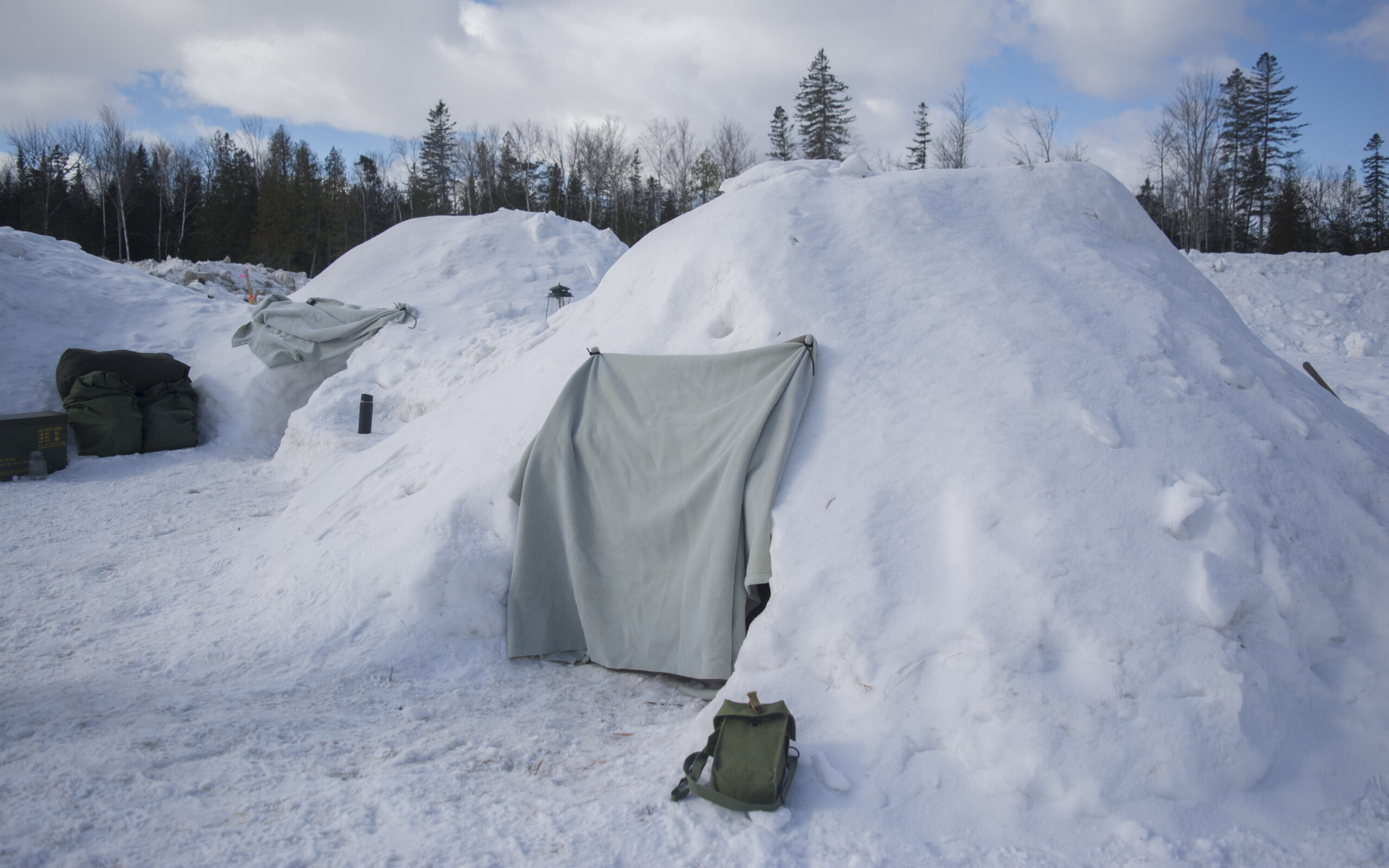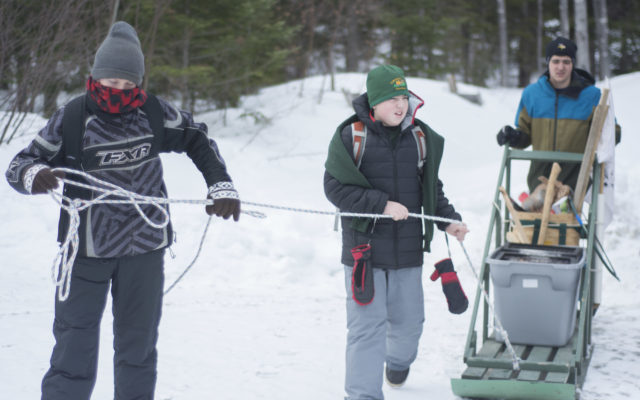
CARIBOU, Maine — Above average temperatures led to a warmer Boy Scout Winterama than usual over the weekend, but with still plenty of snow, allowing local troops to build shelters for the first time in two years and to compete for a large trophy.
Vaughn Keaton, the Caribou Troop 184 Scoutmaster who led the event, implemented a variety of changes to the weekend survival-skills competition inspired by the show “Survivor.”
After scouts spent Friday night in their handmade shelters, Saturday began with Keaton passing around an empty coffee can full of numbers to all Scouts. Each number drawn corresponded with a new team, mixing up the dynamic and placing the Scouts in unfamiliar social territory.
As they formed groups and left the Aldrich Road lodge, participants gathered around their respective Klondike Derby sleds and began introducing themselves before heading up an ATV trail and participating in the morning’s events.
At noon, the Scouts returned to their normal groups for the cooking portion of the event. Even here, Keaton threw the boys for a loop and gave each troop two secret ingredients, a kielbasa sausage and an onion, that they had to incorporate in their meals.
“Sometimes Scouts will bring the simplest meal because they don’t expect to win the cooking competition,” Keaton said, adding that the surprise will hopefully cause Scouts to consider culinary alternatives when preparing their meals in future.
Other events with a twist involved knot tying, a helicopter crash, a puzzle, and a blindfolded retriever competition.
While knot tying has always been a part of Winterama, this time around Keaton required the youngsters to use their rope tying skills while simulating having to save someone who had fallen through ice into a frozen lake.
Scout officials dug a hole in the snow, where the “victim” was made to stand, and Scouts needed to determine what knots to use to tie their ropes together and in what order. The finished rope would be connected to a tree to help save the individual.
Keaton said the Scouts use different knots for different applications and had to “tie everything together using the right knots.”
With the helicopter crash exercise, Scouts needed to pick five items out of 20 that would be essential in such a survival scenario.
“The other fifteen are just useless junk,” he told the participants, “but if you want to survive you have to pick the five best items.”
The puzzle game was a new addition to the afternoon series of events, which had Scouts back with their normal troops. In this competition, competitors had to fit pieces together on a frame and board created by S.W. Collins and, while the pieces were fairly large, they were cut at slightly different lengths, causing anyone who rushed through the puzzle to have results that may have appeared nearly complete, but may have needed to be completely rearranged.
Keaton added another twist to the puzzle by having Scouts first go through a keychain with a few dozen keys to find the right one to unlock a box containing all the puzzle boards.
The blindfolded retriever competition, however, is where communication was really put to the test, as Scouts were mixed and matched in the morning with boys from other towns and troops.
As the name suggests, one scout was blindfolded and asked to retrieve a flag at the end of an obstacle course. Another teammate, with his back to the blindfolded boy, shouted directions given to him by another scout, who was facing the obstacle course, but could only give hand signals.
Assistant Scoutmaster Steve Austin manned the retriever station on Saturday morning, holding a clipboard and timing the boys.
Austin said the event was a great way to build communication and teamwork skills, and said the boys seemed to be enjoying the event.
“The fact that they’re mixed up adds a little twist,” Austin said, “and this station forces them to communicate with one another and hopefully build friendships.”
Another aspect of the challenge, according to Austin, involved remembering to reverse all directions when the blindfolded Scout returned with the flag.
“The boys always try to remember to yell ‘the other right,’” he said, “but for the most part everything’s been going very well.”
Keaton said nearly all the unexpected additions to the event were inspired by “Survivor.”
“I watch ‘Survivor’ a lot,” he said, “and as I’m watching these games I think “that’d be good to do in Scouts.’”
- Scouts participating in this year’s Klondike Derby as part of the Boy Scouts Winterama in Caribou spent the morning on teams consisting of boys from other troops. Here, from left, Scouts Josh Fortin, Cameron Belanger, and Aidan Plante can be seen pushing a sled on their way to several stations featuring competitive events. (Christopher Bouchard)
Keaton added that, in the morning, things were a little hectic because Scouts did not expect to be separated from their groups, and that out of nine units, only three built shelters on Friday and stayed in them overnight on both Friday and Saturday. Other troops only participated in the day-long activities on Saturday.
Out of those three, Troop 194 of Fort Fairfield won the overall trophy, Troop 184 of Caribou received second place honors, and Troop 271 of Presque Isle came in third.
Brian Bixler, assistant Scout leader for Fort Fairfield, worked with the boys to create three igloo-shaped shelters and said this winter’s weather made the task particularly difficult.
“In the past, they’ve been pretty easy to build, but with the weather this year and the thick layer of ice on everything, it was just murder to build these things,” Bixler said.
With perfect conditions, Bixler said the Fort Fairfield Scouts have been able to build seven or eight shelters in a single day.
“It was a full day with about 20 people,” he said, “but with this stuff, we had a snowblower going and all the kids working, and it was all we could do to get two built in a day.”
Bixler said the Fort Fairfield Troop currently consists of two Boy Scouts and one Cub Scout, and that everyone is “brand new this year.”
“I’m the only one from the old group of scouts,” he said. “We actually ran out of boys, they all aged out, so we went dormant for almost a year and I’m kind of the old trainer now.”
Fort Fairfield Scouts set up a dome-shaped wood form and piled snow on top of it to build their outdoor shelters. Once the snow had compacted over the dome, the wood form was collapsed and pulled out through an opening. Bixler said this is one of several building methods and that it often saves about two hours, as Scouts ultimately spend less time hollowing out their igloos.
Friday night was the first time any of the new troops had slept outside during the winter, and Bixler said there were no serious issues.
“If you light one candle inside, it will keep everything around 25 degrees,” he said, “regardless of how cold it is outside. It doesn’t matter if it’s 5 degrees or negative 25 out there. Snow is a great insulator.”
Even though Scouts had the option to return to the Scout lodge if they were cold during the night, or to warm up in an ice fishing shack brought by the Fort Fairfield scoutmaster, Bixler said all of the boys stayed in their handmade shelters.
“We have our own emergency shelter right here,” he said, “but nobody used it. They all toughed it out.”








